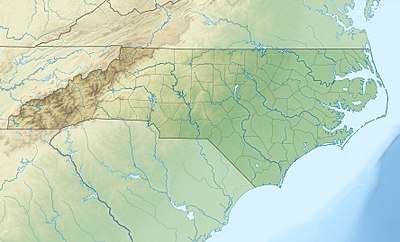Terrells Creek (Haw River tributary, right bank)
Terrells Creek is a 12.47 mi (20.07 km) long 3rd order tributary to the Haw River, right bank in Chatham County, North Carolina.
| Terrells Creek Tributary to Haw River, right bank | |
|---|---|
 Location of Terrells Creek mouth  Terrells Creek (Haw River tributary, right bank) (the United States) | |
| Location | |
| Country | United States |
| State | North Carolina |
| County | Chatham |
| Physical characteristics | |
| Source | divide between Terrell Creek and Varnell Creek (Rocky River) |
| ⁃ location | pond about 0.25 miles north of Silk Hope, North Carolina |
| ⁃ coordinates | 35°47′07″N 079°22′11″W[1] |
| ⁃ elevation | 610 ft (190 m)[2] |
| Mouth | Haw River |
⁃ location | about 1 mile north of Terrells, North Carolina |
⁃ coordinates | 35°49′59″N 079°22′11″W[1] |
⁃ elevation | 374 ft (114 m)[2] |
| Length | 12.47 mi (20.07 km)[3] |
| Basin size | 29.13 square miles (75.4 km2)[4] |
| Discharge | |
| ⁃ location | Haw River |
| ⁃ average | 34.85 cu ft/s (0.987 m3/s) at mouth with Haw River[4] |
| Basin features | |
| Progression | east-northeast |
| River system | Haw River |
| Tributaries | |
| ⁃ left | Johnson Branch Cattail Creek |
| ⁃ right | unnamed tributaries |
| Bridges | Silk Hope Lindley Mill Road, White Smith Road, Castle Rock Farm Road, NC 87, Mt. Olive Church Road |
Variant names
According to the Geographic Names Information System, it has also been known historically as:[1]
- Terrell Creek
Course
Terrells Creek rises in a pond about 0.25 miles north of Silk Hope, North Carolina in Chatham County and then flows east-northeast to the Haw River about 1 mile north of Terrells.[2]
Watershed
Terrells Creek drains 29.13 square miles (75.4 km2) of area, receives about 47.4 in/year of precipitation, and has a wetness index of 424.76 and is about 55% forested.[4]
References
- "GNIS Detail - Terrells Creek". geonames.usgs.gov. US Geological Survey. Retrieved 30 September 2019.
- "Terrells Creek Topo Map, Chatham County NC (Bynum Area)". TopoZone. Locality, LLC. Retrieved 30 September 2019.
- "ArcGIS Web Application". epa.maps.arcgis.com. US EPA. Retrieved 30 September 2019.
- "Terrells Creek Watershed Report". Waters Geoviewer. US EPA. Retrieved 30 September 2019.
This article is issued from Wikipedia. The text is licensed under Creative Commons - Attribution - Sharealike. Additional terms may apply for the media files.